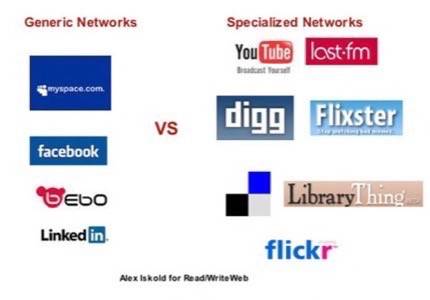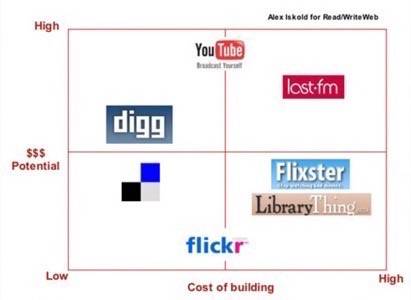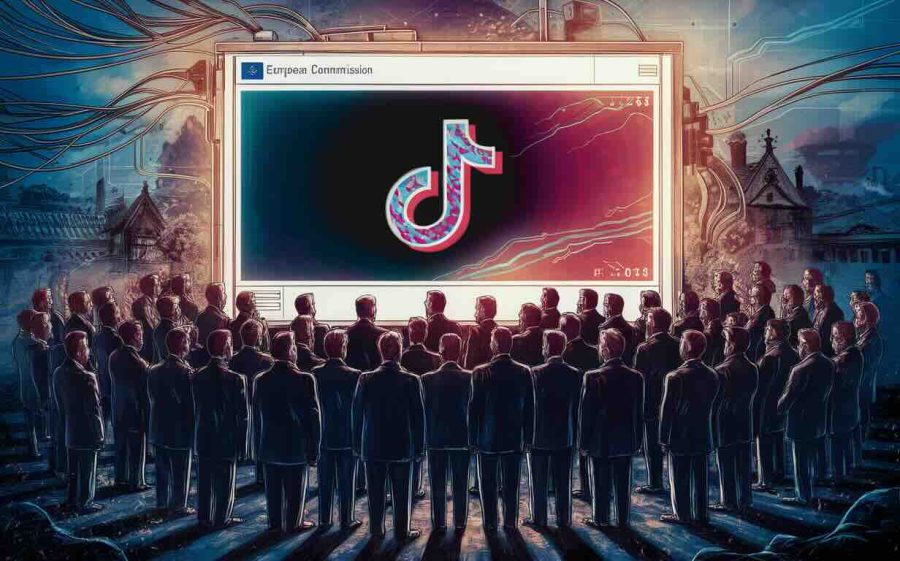Inventing new software for enterprises is really hard. Selling it to them is nearly impossible.
For a startup to break through the thick doors of the enterprise takes years. But even when lady
luck smiles on a startup, the joy is short lived. The next morning its back to the daily grind —
being a one product company means that you constantly have to start over selling to a new place.

Back in the old days IBM had perfected the game of not only opening the enterprise channel, but continuously supplying them
with new products. Enterprises were offered bundles, end-of-the-year specials, discounts and all manner of
tricks that helped keep the channels open.
Fast forward to 2007 and social startups are faced with much the same problem. A handful of them succeeded at
building the modern version of the channel — a large audience of frequent users. But is a large audience enough?
Should the startup perfect what they have or should they leap into another vertical? And if the answer is yes,
how far should the service extend? In this post we will take a closer look at growing social networks and consider
how they are looking at vertical expansion.
Generic Networks vs. Specialized Networks
Before answering the questions posed in the introduction it helps to understand the
differences between generic and specialized social networks. For the purpose of this post,
we define a generic network as one that exists primarily to keep in touch and a specialized network
is one where people are brought together based on the specific common interest. According to this
definition Facebook, MySpace, Bebo and even LinkedIn are considered generic social networks. del.icio.us, Flickr,
LibraryThing and Flixster, on the other hand, represent specialized networks.

The main advantage of a specialized network is that it can offer a better user experience.
Because of its specialty its user interface can be more focused and rich. As an example, consider Flixster. In our recent review we pointed out
the impressive set of features for movie fans. Another good example is Last.fm – a popular
social music site. Last.fm offers its users an add on to iTunes and other popular music players that automatically captures
their music attention data. It then uses sophisticated automation to connect users with similar taste in music.
Thus, Last.fm is an example of a specialized social network with not only a rich set of features, but with a notable
specialized infrastructure.
The disadvantage of specialized networks is that they are somewhat limited to their specialty. It is not a set in stone
limitation as we will discuss below, but it is a limitation. Users perceive specialized networks as such and rolling out
completely different functionality can be surprising and quite risky. On the other hand, generic social networks such as
Facebook have much more flexibility in the set of features that they can build. In fact, adding a specialty is likely
to be perceived positively by most users because they come to generic networks with a “one-stop-shop” mentality.
Generic Networks Adding Specialties
Consider these questions:
- How many Facebook users are also Flickr users?
- Why would a Facebook user also use Flickr?
While we do not know the answer to the first, we can answer the second one. The Facebook user would
only use Flickr to share non-Facebook photos. One possible use case is to share photos with family members who are not Facebook members.
It is clear from people’s profiles, however, that the majority of the Facebook users utilize Facebook’s photo sharing capabilities.
And taking it a bit further, if students are both busy and lazy the chances that they will
use two photo sharing sites is slim. So likely, Facebook wins this faceoff. The same goes for events. Yes, there are
other, richer event sites, but again what Facebook has today is good enough for its users.
As another example of a generic network adding a specialty consider MySpace rolling out
a rather obvious Digg clone. Here the situation is not quite as clear. First,
news is new to the MySpace crowd, which is not really the same audience as on Digg. The jury is still out on this one,
but judging by the top headline things are not going that well so far:

The problem with this integration is that it is simply a clone. Plus, it is not integrated into MySpace
in a way that people could use. Users are forced to essentially go to a separate site. The feature is
not part of the user flow and as a result, MySpace appears not to have properly leveraged their enormous audience. To be successful,
the integration needs to be meaningful.
What Expansions Make Sense?
However unsuccessful a single integration may be, we know that a successful integration can be
potentially valuable for both the expansion and retention of an existing user base. Lets look at the broader
set of opportunities for existing generic social networks:

The single most important metric for the social networks looking at a vertical is monetization.
Over the last few years these sites mastered the eyeballs game and they now need to demonstrate
value by turning those eyeballs into dollars. This can be done in a few ways, though the major ones are
advertising and affiliate programs. Looking at the diagram above, we see for example, that social bookmarking
and social news verticals could be interesting plays. Both of these do not have much technical complexity
and have straightforward, but perhaps limited, monetization in the form of text ads.
Last.fm and other music social networks are difficult to replicate because of their more technical
feature set. However, since music market is huge, we can expect that more generic social networks would
be considering it. Clearly MySpace is already there, and has been since day one, but Facebook might still consider
launching a wider music play, particularly because of its appeal to students (who are notorious consumers of popular music). Along the same lines, film and
book offerings might also make sense from the monetization point of view. Photos and videos are tougher to monetize,
but we should expect that generic social networks might get into video sharing as soon as someone figures out
profitable and clean way of making money in this vertical.
Conclusion
As the competition between generic social networks heats up and the pressure to monetize the
audience increases we are likely to see these sites add support for more verticals. Despite the fact
that they are not going to be able to offer the same rich set of features that specialized networks
are can offer their die hard fans, the expansion is threatening. The generic social networks have these
advantages:
- They have a bigger audience to play with
- They can get away with 80% of features
- They have the luxury to try different things and “see what sticks”

However, adding too many specialties might be bad, because not all of them will
be effectively integrated and absorbed (again, see the MySpace News example), and this could turn off regular users of the site. The generic networks
need to consider costs, upside, and most importantly, their audience before integrating a particular vertical.
The right mix of verticals can lead to faster growth and definitive monetization.
We are already seeing examples of these expansions and more are likely to follow. Which ones?
Only the time will tell. Please let us know what you think is likely to happen next.
The title image is from iConnectDots










